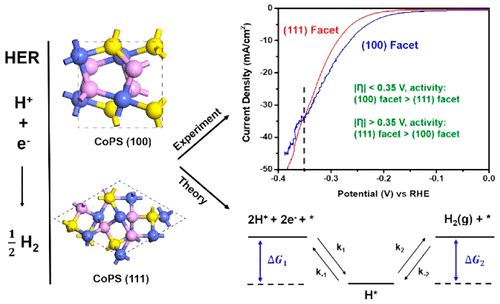当前位置:
X-MOL 学术
›
ACS Catal.
›
论文详情
Our official English website, www.x-mol.net, welcomes your feedback! (Note: you will need to create a separate account there.)
Crystallographic Facet Dependence of the Hydrogen Evolution Reaction on CoPS: Theory and Experiments
ACS Catalysis ( IF 12.9 ) Pub Date : 2018-01-12 00:00:00 , DOI: 10.1021/acscatal.7b03167 Tao Wu 1, 2 , Michael L. Stone 1 , Melinda J. Shearer 1 , Matthew J. Stolt 1 , Ilia A. Guzei 1 , Robert J. Hamers 1 , Ruifeng Lu 2 , Kaiming Deng 2 , Song Jin 1 , J. R. Schmidt 1
ACS Catalysis ( IF 12.9 ) Pub Date : 2018-01-12 00:00:00 , DOI: 10.1021/acscatal.7b03167 Tao Wu 1, 2 , Michael L. Stone 1 , Melinda J. Shearer 1 , Matthew J. Stolt 1 , Ilia A. Guzei 1 , Robert J. Hamers 1 , Ruifeng Lu 2 , Kaiming Deng 2 , Song Jin 1 , J. R. Schmidt 1
Affiliation

|
Cobalt phosphosulfide (CoPS) has recently emerged as a promising earth-abundant electrocatalyst for the hydrogen evolution reaction (HER). Nonetheless, the influence of crystallographic surface on the HER activity of CoPS and other nonmetallic electrocatalysts remains an important open question in the design of high-performance catalysts. Herein, the HER activities of the (100) and (111) facets of CoPS single crystals were studied using complementary experimental and computational approaches. Natural (111) and polished (100) facets of CoPS single crystals were selectively exposed to reveal that the HER behaviors on these two facets are quite different, with current density–potential curves crossing near 0.35 V vs RHE. Computational analysis can explain this phenomenon in terms of strongly differing H atom adsorption free energies and H–H recombination barriers on the facets, in conjunction with a simple kinetic model. At low potential (0–0.35 V), H adsorption (Volmer step) is rate limiting due to the endergonic adsorption on the (111) facet vs exergonic adsorption on the (100) facet, yielding a faster HER rate for the latter. However, at high potential (>0.35 V), H2 recombination/desorption becomes limiting and thus the (111) facet, with lower associated barriers, shows better HER activity. Explicit consideration of both steps and their interplay allows for a comprehensive description of the overpotential-dependence of the HER activity. This integrated study yields additional insight into the factors which govern the facet-dependence of catalytic activity on nonmetallic electrocatalysts and can further improve the design of advanced nanostructured HER catalysts.
中文翻译:

氢析出反应对CoPS的晶体学影响:理论与实验
磷硫化钴(CoPS)最近已成为一种有前途的富氢电析氢反应(HER)电催化剂。尽管如此,晶体表面对CoPS和其他非金属电催化剂的HER活性的影响仍然是高性能催化剂设计中的一个重要的开放性问题。在本文中,使用互补的实验和计算方法研究了CoPS单晶的(100)和(111)面的HER活性。选择性地暴露了CoPS单晶的自然(111)和抛光(100)面,以揭示这两个面上的HER行为非常不同,电流密度-电位曲线与RHE的交点接近0.35V。计算分析可以结合一个简单的动力学模型,用不同方面的氢原子吸附自由能和氢-氢复合势垒大为不同来解释这种现象。在低电位(0–0.35 V)下,H吸附(沃尔默阶跃)受到速率限制,这是由于(111)面上的负电子吸附与(100)面上的能电吸附相比,后者的HER速率更快。但是,在高电位(> 0.35 V)下,H2重组/解吸变得受限,因此具有较低相关屏障的(111)小平面显示出更好的HER活性。明确考虑这两个步骤及其相互影响,可以全面描述HER活动的过度电势依赖性。这项综合研究对控制非金属电催化剂催化活性的面相关性的因素提供了更多的见解,并且可以进一步改善先进的纳米结构HER催化剂的设计。
更新日期:2018-01-12
中文翻译:

氢析出反应对CoPS的晶体学影响:理论与实验
磷硫化钴(CoPS)最近已成为一种有前途的富氢电析氢反应(HER)电催化剂。尽管如此,晶体表面对CoPS和其他非金属电催化剂的HER活性的影响仍然是高性能催化剂设计中的一个重要的开放性问题。在本文中,使用互补的实验和计算方法研究了CoPS单晶的(100)和(111)面的HER活性。选择性地暴露了CoPS单晶的自然(111)和抛光(100)面,以揭示这两个面上的HER行为非常不同,电流密度-电位曲线与RHE的交点接近0.35V。计算分析可以结合一个简单的动力学模型,用不同方面的氢原子吸附自由能和氢-氢复合势垒大为不同来解释这种现象。在低电位(0–0.35 V)下,H吸附(沃尔默阶跃)受到速率限制,这是由于(111)面上的负电子吸附与(100)面上的能电吸附相比,后者的HER速率更快。但是,在高电位(> 0.35 V)下,H2重组/解吸变得受限,因此具有较低相关屏障的(111)小平面显示出更好的HER活性。明确考虑这两个步骤及其相互影响,可以全面描述HER活动的过度电势依赖性。这项综合研究对控制非金属电催化剂催化活性的面相关性的因素提供了更多的见解,并且可以进一步改善先进的纳米结构HER催化剂的设计。



























 京公网安备 11010802027423号
京公网安备 11010802027423号